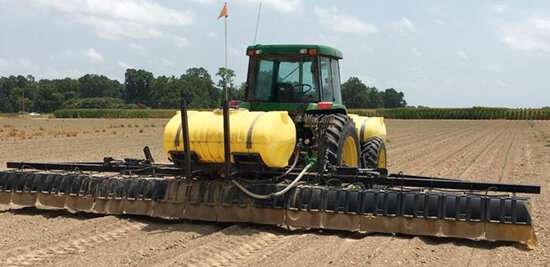This article has been reviewed according to Science X's editorial process and policies. Editors have highlighted the following attributes while ensuring the content's credibility:
fact-checked
trusted source
proofread
Researchers aim to reduce pesticide drift in the lower Mississippi Delta

To reduce the effects of pesticide drift and protect pollinators, researchers with the U.S. Department of Agriculture's Agricultural Research Service (ARS) in Stoneville, Mississippi, are investigating the best ways of using hooded sprayers and conventional (unhooded) sprayers.
Pesticide drift occurs when pesticide dust or droplets move through the air to another place other than the target area during or after pesticide application. This off-target drift can cause crop damage as well as health concerns to humans, animals, and beneficial insects such as bees and biocontrol agents exposed to the chemicals.
ARS researcher Narayanan Kannan and his team member Christina Huggins from the ARS Pollinator Health in Southern Crop Ecosystems Research Unit in Stoneville, Mississippi, studied ground-based pre-emergent herbicide applications for corn, soybean, and cotton on three regional, commercial-scale farms and four USDA research farms in Mississippi's Washington and Bolivar counties. After collecting samples of the drifted spray droplets, the researchers calculated the drift volume and drift distance from preemergent herbicide applications. The study was published in Applied Engineering in Agriculture.
"We found that there was up to 63% reduction in pesticide drift of pre-emergent herbicide applications using a hooded sprayer in comparison to a nonhooded, conventional sprayer," said Kannan.
Kannan said that hooded or shielded sprayers attached to tractors effectively minimized the exposure of herbicide spray to wind and led to fewer off-target depositions.
While hooded sprayers have advantages, the presence of a physical shield can pose challenges during road transport or repairing nozzles when compared to conventional sprayers. If a farmer does not have access to a hooded sprayer or prefers to use a conventional sprayer, mitigating pesticide drift is still possible by avoiding high wind speed and high temperature during spraying.
"For example, our study's results also showed 74% reduction in pesticide drift when using a conventional sprayer in low wind conditions, when possible," said Kannan.
Researchers also found a reduced proportion of herbicide drifting with a longer sprayer boom length during preemergent herbicide applications.
According to USDA's National Agricultural Statistics Service, the Lower Mississippi Delta is one of the most intensively cultivated and productive agricultural regions in the United States. Corn, soybean, and cotton are the most widely cultivated crops in the region.
Studying preemergent herbicide application during active planting months for these crops is important to understanding pesticide drift, as farmers sometimes face limited opportunities to spray as a result of unfavorable weather or wet soil conditions.
More information: Narayanan Kannan et al, Opportunities to Mitigate Particle Drift from Ground-Based Preemergent Herbicide Applications, Applied Engineering in Agriculture (2023). DOI: 10.13031/aea.15307
Provided by Agricultural Research Service





















